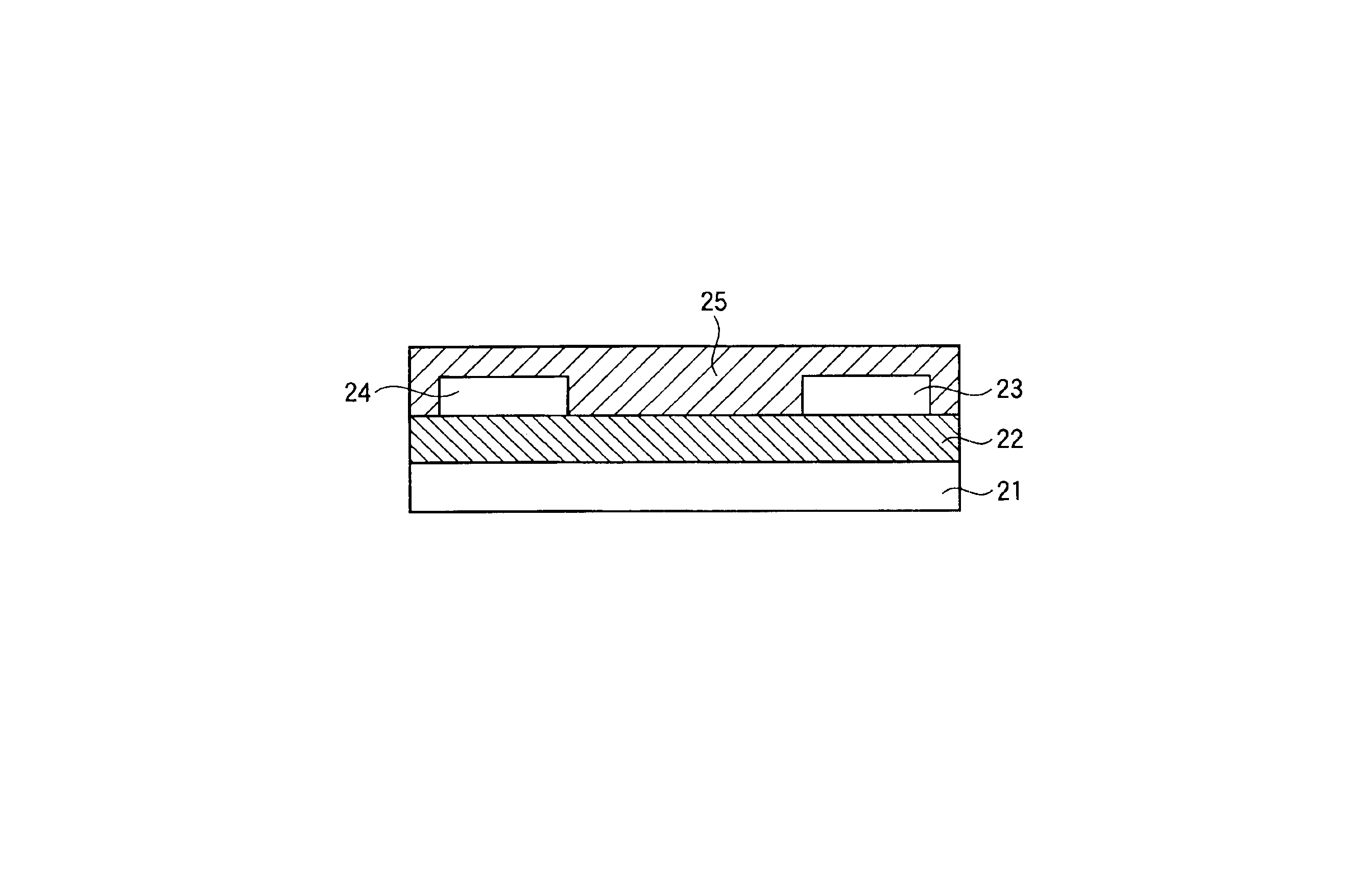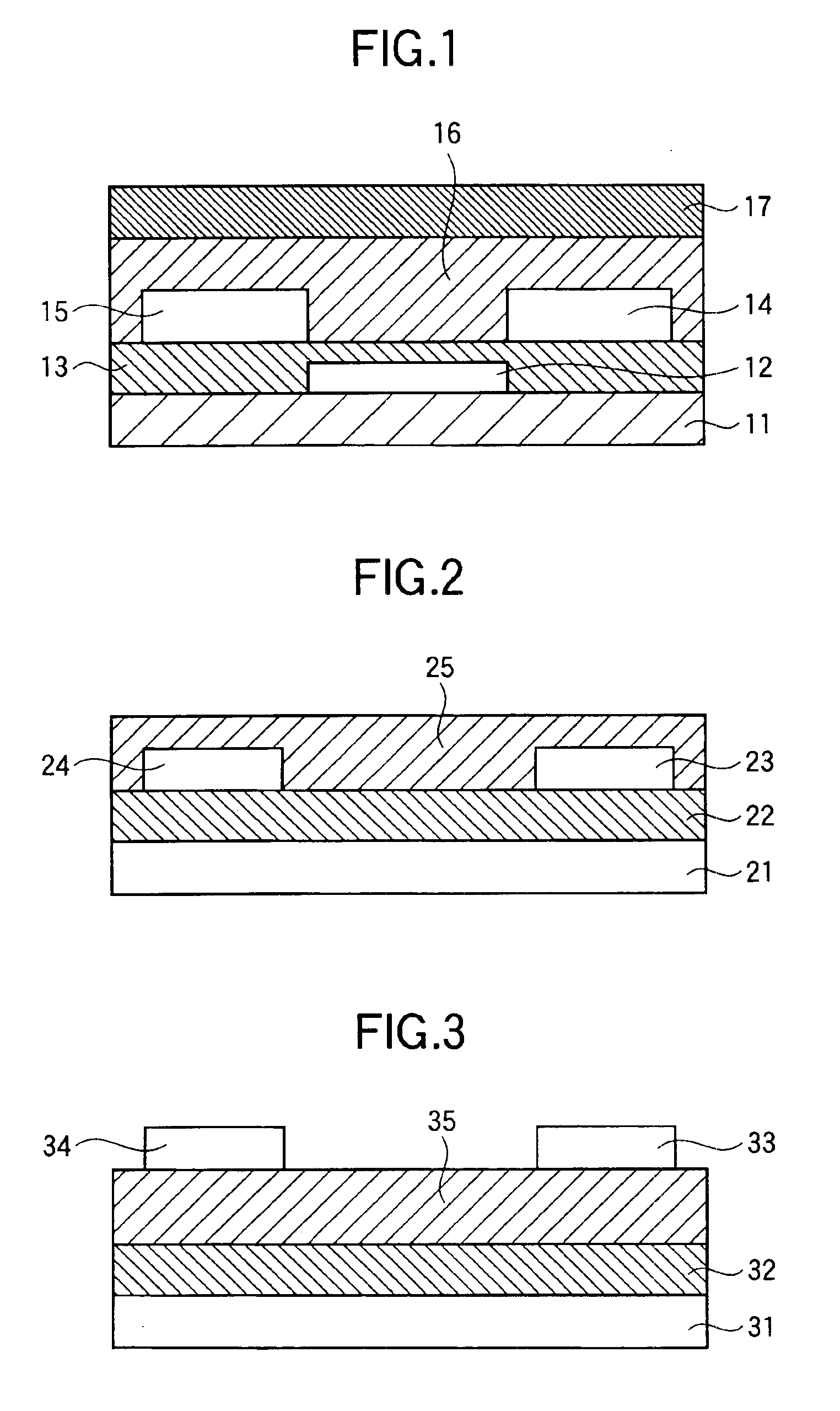Field-effect organic transistor
a field-effect organic transistor and transistor technology, applied in transistors, solid-state devices, thermoelectric devices, etc., can solve the problems of low mobility of organic semiconductors, low threshold voltage, fluctuation of threshold voltage, etc., and achieve low threshold voltage and high mobility.
- Summary
- Abstract
- Description
- Claims
- Application Information
AI Technical Summary
Benefits of technology
Problems solved by technology
Method used
Image
Examples
example 1
FIG. 2 shows a structure of the field-effect organic transistor prepared in Example 1.
As the gate electrode 21, an n-type, highly-doped silicon substrate was used; as the gate insulating layer 22, SiO2 was used; as the source electrode 23 and the drain electrode 24, a chromium / gold stack was used; and as the organic semiconductor layer 25, the condensed aromatic ring compound A represented by the following chemical formula.
The procedure for forming the field-effect organic transistor is described below.
On the silicon substrate, a 300 nm thick, thermally oxidized film SiO2 was formed. The source and drain electrodes of chromium (thickness: 5 nm) / gold (thickness: 100 nm) having a channel length of 50 μm and a channel width of 50 mm were formed thereon by the lift-off method. The organic semiconductor layer 25 was formed by sublimating the condensed aromatic ring compound A in a metal sublimating boat being 10 cm apart from the substrate, at 5×10−6 torr at an average sublimation rate ...
example 2
The field-effect organic transistor having the same structure as the one prepared in Example 1 as shown in FIG. 2 was prepared using an n-type, highly-doped silicon substrate as the gate electrode 21, SiO2 as the gate insulating layer 22, the chromium / gold stack as the source electrode 23 and the drain electrode 24, and the condensed aromatic ring compound C represented by the following chemical formula as the organic semiconductor layer 25.
The procedure for forming the field-effect organic transistor is described below.
On the silicon substrate 21, a 300 nm thick, thermally oxidized film SiO2 was formed. The source and drain electrodes of chromium (thickness: 5 nm) / gold (thickness: 100 nm) having a channel length of 50 μm and a channel width of 50 mm were formed thereon by the lift-off method. The organic semiconductor layer 25 was formed thereon by applying a 0.01 g / mL chloroform solution of the condensed aromatic ring compound C by spin coating, and drying at 150° C. for 12 hours...
example 3
The field-effect organic transistor having the same structure as prepared in Example 2, as shown in FIG. 2 was prepared using an n-type, highly-doped silicon substrate as the gate electrode 21, polyvinyl phenol as the gate-insulating layer 22, gold as the source electrode 23 and the drain electrode 24, and the condensed aromatic ring compound C as the organic semiconductor layer 25.
The procedure for forming the field-effect organic transistor is described below.
2-propanol solution of polyvinyl phenol (0.1 g / mL) was applied by spin coating on the silicon substrate and dried at 150° C. for 6 hours to form a gate insulating layer. Thereon, gold (50 nm) was deposited by vacuum evaporation to produce source and drain electrodes with a channel length of 50 μm and a channel width of 10 mm. Thereon, chloroform solution of the condensed aromatic ring compound C (0.01 g / ml) was applied by spin coating and dried at 150° C. for 12 hours to form an organic semiconductor layer 25. The gate electr...
PUM
| Property | Measurement | Unit |
|---|---|---|
| energy band gap | aaaaa | aaaaa |
| channel width | aaaaa | aaaaa |
| channel length | aaaaa | aaaaa |
Abstract
Description
Claims
Application Information
 Login to View More
Login to View More - R&D
- Intellectual Property
- Life Sciences
- Materials
- Tech Scout
- Unparalleled Data Quality
- Higher Quality Content
- 60% Fewer Hallucinations
Browse by: Latest US Patents, China's latest patents, Technical Efficacy Thesaurus, Application Domain, Technology Topic, Popular Technical Reports.
© 2025 PatSnap. All rights reserved.Legal|Privacy policy|Modern Slavery Act Transparency Statement|Sitemap|About US| Contact US: help@patsnap.com



